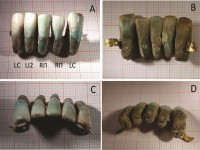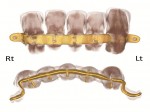In 2010, archaeologists from the University of Pisa excavated the tomb of the powerful Guinigi family in the San Francesco Monastery at Lucca. Scions of the wealthy family of merchants and bankers had ruled the city of Lucca from 1392 until 1430 as capitani del popolo (captains of the people, ie, dictators), and even after the family was overthrown and the Republic reinstated, the Guinigi remained one of the most prominent families in Lucca for centuries.
In 1358, the Guinigi Chapel was built near the convent of San Francesco. The bodies of family members were buried in the private chapel through the first half of the 17th century. Instead of being interred in separate areas, the remains were laid to rest in two large collective tombs. Over the years the bones were shifted around to make room, so when archaeologists excavated the chambers, the remains of more than 200 people were disarticulated and commingled making it impossible to reconstruct the skeletons of individuals.
 Mixed in with the jumbled skeletal remains in the lowest stratigraphic layer of the south tomb, the team discovered a unique archaeological treasure: a centuries-old dental prosthesis. It is made of five human teeth — three central incisors and two lateral canines — joined by a gold band running through the root ends of the teeth. The teeth all came from different, let’s just say, donors. (Shoutout to Fantine from Les Miserables.) Examination under a microscope and CT scans found that the roots of the teeth were cut and abraded to relative evenness. Then the a thin cut was made across the bases of the teeth and a thin gold was inserted into the cuts. Two small holes were cut in each tooth and gold pins inserted to fix the tooth to the band. At each end of the device, the gold was bent into s-shapes and pierced with a hole. These ends were attached to the living teeth, likely with ties, as indicated in illustrations of similar dental prosthetics from the 16th and 18th centuries
Mixed in with the jumbled skeletal remains in the lowest stratigraphic layer of the south tomb, the team discovered a unique archaeological treasure: a centuries-old dental prosthesis. It is made of five human teeth — three central incisors and two lateral canines — joined by a gold band running through the root ends of the teeth. The teeth all came from different, let’s just say, donors. (Shoutout to Fantine from Les Miserables.) Examination under a microscope and CT scans found that the roots of the teeth were cut and abraded to relative evenness. Then the a thin cut was made across the bases of the teeth and a thin gold was inserted into the cuts. Two small holes were cut in each tooth and gold pins inserted to fix the tooth to the band. At each end of the device, the gold was bent into s-shapes and pierced with a hole. These ends were attached to the living teeth, likely with ties, as indicated in illustrations of similar dental prosthetics from the 16th and 18th centuries
 Because it was found in the earliest layer, it may date to as early as the 14th century, but it would have been very easy for the dentures to fall through successive layers of bones, so stratigraphy is of no help in dating the piece. This was highly advanced dentistry in Early Modern Europe. The gold band technology was mentioned in period sources from Guy de Chauliac (ca. 1300-1368), the French physician who first recognized there were two kinds of plague, Bubonic and Pneumonic, to Pierre Fauchard (1678–1761), the father of modern dentistry.
Because it was found in the earliest layer, it may date to as early as the 14th century, but it would have been very easy for the dentures to fall through successive layers of bones, so stratigraphy is of no help in dating the piece. This was highly advanced dentistry in Early Modern Europe. The gold band technology was mentioned in period sources from Guy de Chauliac (ca. 1300-1368), the French physician who first recognized there were two kinds of plague, Bubonic and Pneumonic, to Pierre Fauchard (1678–1761), the father of modern dentistry.
Archaeologists were not able to match the dentures to any of the mandibles found in the tomb, but the presence of dental calculus covering the holes indicate the prosthetic was used for many years. Indeed, Fauchard’s description of such appliances emphasizes their longevity. From the 1746 edition of his treatise Le Chirurgien dentiste, ou Traité des dents:
“Teeth and artificial dentures, fastened with posts and gold wire, hold better than all others. They sometimes last 15–20 years and even more without displacement. Common thread and silk, used ordinarily to attach all kinds of teeth or artificial pieces, do not last long.”
 The dentures found in the Guinigi predate Fauchard by at least a century, but they are notably more complex than the device he describes. The gold band runs inside the roots of the teeth, fastened with pins and the appliance is anchored to in situ teeth with those s-shaped ends. Fauchard just attaches a band to the lingual and buccal surface of the teeth using strings run through holes drilled into the teeth.
The dentures found in the Guinigi predate Fauchard by at least a century, but they are notably more complex than the device he describes. The gold band runs inside the roots of the teeth, fastened with pins and the appliance is anchored to in situ teeth with those s-shaped ends. Fauchard just attaches a band to the lingual and buccal surface of the teeth using strings run through holes drilled into the teeth.
One member of the team, Dr Simona Minozzi, said: “Although there are descriptions of similar objects in texts from the period, there is no known archaeological evidence. The dentures found in the tomb are the first example of dentures from this historical period, and as such are a valuable addition to the history of dentistry.”
The study of the dental appliance has been published in the journal Clinical Implant Dentistry and Related Research. It is not, alas, freely available for perusal, but if you have an institutional subscription or six bucks to spare, you can enjoy some more detailed images of the holes, gold band and dental plaque.
Did the Guinigi family Inspire the name for Guinigivitis?
Ahhhh, at laft – Fere fey are !
…and g(u)ingiva if Latin, of courfe.
Turds, false teeth, baby crocs: what’s going on? These would be more fitting before Hallowe’en than before Thanksgiving.
(Have I quite caught the tone of a canting , pious, PC nag?)